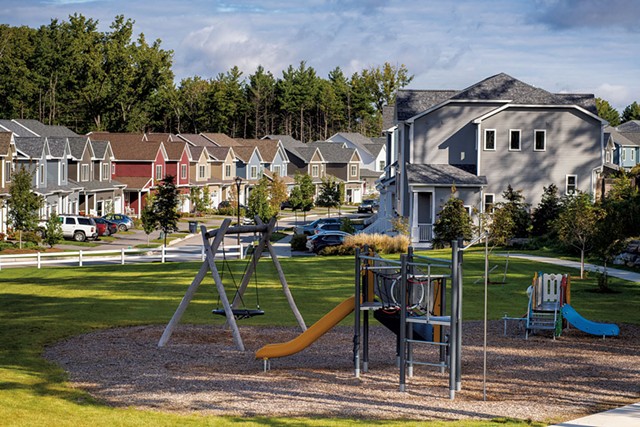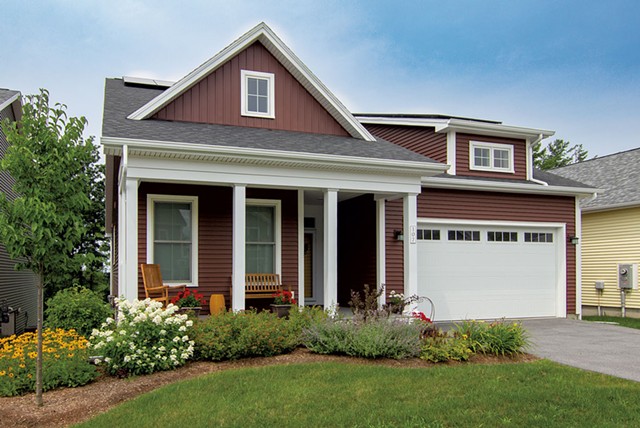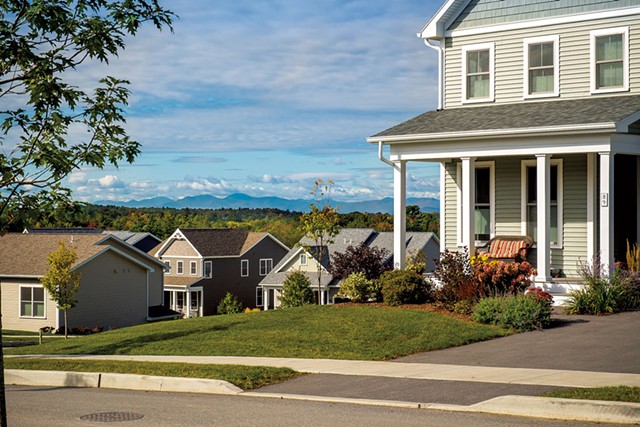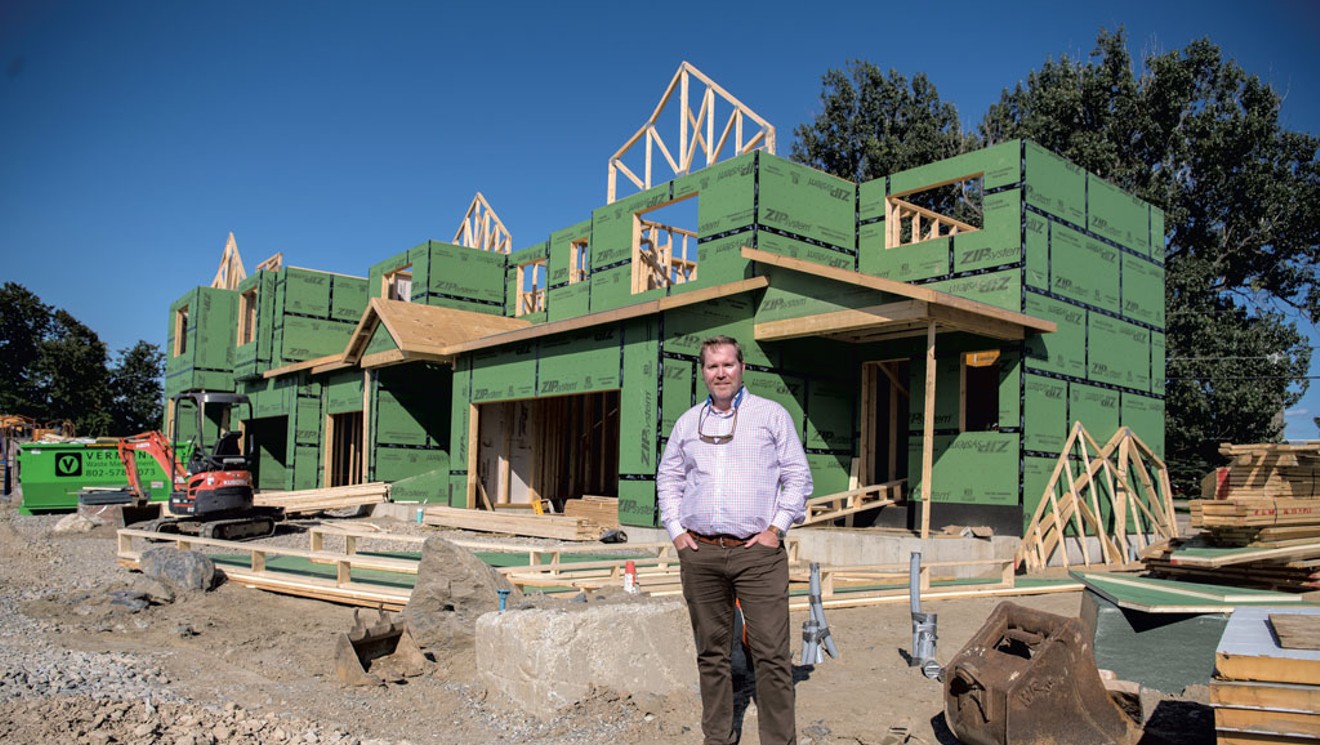click to enlarge
- Daria Bishop
- Above: O’Brien Brothers CEO Evan Langfeldt at the construction site of Hillside East in South Burlington
Hot on the heels of a stormy summer and historic flooding, the O’Brien Brothers development firm is creating a South Burlington community designed to stay powered up through the wild weather that’s expected as a result of climate change.
The development is fossil fuel-free and features amenities that lower the carbon output of appliances and keep them running when the power goes out.
The neighborhood is part of a 900-unit development near Route 116 called Hillside at O’Brien Farm, on the rolling hills of a former dairy farm. The first phase of the 15-year project included 115 newly completed single-family homes, all of which have sold or are under contract.
The second phase, now in progress, includes 155 net-zero homes that are designed to produce about as much power as they consume. Known as Hillside East, it will be one of the first neighborhoods in the country to share power on a microgrid, a small-scale power grid that connects homes in the net-zero development with each other and with the electric company Green Mountain Power.
click to enlarge 
- Courtesy Of Sally Mccay
- Hillside at O’Brien Farm
Net-zero neighborhoods exist in a few other states, and more are being developed, including some by large national homebuilders such as KB Home and Toll Brothers. But Hillside East is the only such development in Vermont, according to Kristin Carlson, chief energy services executive at Green Mountain Power.
The homes come with rooftop solar panels, electric vehicle chargers and individual power storage in the form of Tesla Powerwall batteries that will turn on if the power turns off. Those home electrical systems will also be backed up by a large community battery storage system, and a SPAN power usage dashboard will show residents — and Green Mountain Power — daily energy use and how to find savings.
With July’s flooding and torrential rains still on the minds of many, Hillside East presents an attractive opportunity to avoid spending days without power, as many people did after the floodwaters damaged infrastructure in central and southern Vermont.
“The homes are built with the increasing ferocity of storms in mind,” O’Brien Brothers CEO Evan Langfeldt said. “If the grid goes down, you’ve got your Tesla Powerwalls backing up your power.”
In the middle of January, when solar panels are less effective, the Powerwalls can provide backup electricity. The on-site battery storage will also kick in if needed — enabling homes to share stored energy at peak times, when regional power grid prices are highest.
Langfeldt said he got in touch with Green Mountain Power last year to talk about making low-emission homes as part of the Hillside development. He had been reading about sustainable housing development projects around the country and wanted to create one at his company’s large, multiyear project.
“The fact that there is zero fossil fuel infrastructure on-site is a big component,” Langfeldt said. “It’s the right thing to do, and it makes sense to our customers to move in this direction because it’s the way the world is shifting anyway.”
Green Mountain Power jumped on board. The utility works with many developers to provide more sustainable and resilient power — it has installed more than 4,900 Tesla Powerwall batteries, each roughly the size of a sleek suitcase, in Vermont homes. It also recently completed a solar generation project in Panton that includes a microgrid. Now it’s working with the towns of Grafton, Rochester and Brattleboro to create renewable energy projects tailored to local needs.
click to enlarge 
- Courtesy
- A farmhouse-style home at Hillside
That work has won the utility, which serves 270,000 customers, national press and awards, including a few from business technology magazine Fast Company, which last year named it one of the top-five most innovative companies in North America.
“I’ve heard great things about Green Mountain Power,” said an envious Sara Hammerschmidt, an engineer and planner who is director of sustainable development for a housing project called Veridian at County Farm in Ann Arbor, Mich. Hammerschmidt said power companies — including the one in her area — often create obstacles, not opportunities, when it comes to using batteries and microgrids to share power in housing developments.
Langfeldt acknowledged the dynamic. “We couldn’t do this without a cooperating utility company,” he said.
To guide net-zero development, several communities and organizations have developed construction standards aimed at reducing emissions from new homes. The U.S. Department of Energy’s standard is called the Zero Energy Ready Home Program, which creates a home that is so efficient that a renewable energy system can offset most or all of its power use, delivering kilowatts back to the grid.
That’s the standard the Hillside East homes will meet, Langfeldt said.
The private homebuilding industry’s movement toward curtailing emissions aligns with a public strategy to lower Vermont’s carbon footprint. Heating is responsible for about a third of Vermont’s carbon emissions, second to transportation. Earlier this year, lawmakers passed a clean heat energy standard, a policy, endorsed by the Vermont Climate Council, meant to help the state reach its greenhouse gas emission-reduction requirements by 2030.
Under the standard, fuel dealers must decrease the amount of fossil fuel they sell over time or find ways to offset emissions from those fuels, such as assisting customers with the installation of electric heat pumps and pellet stoves.
The American Craftsman- and farmhouse-style energy-efficient homes at Hillside East won’t look any different on the outside from their carbon-emitting peers in the development. Even on the inside, it’s not readily apparent that heating and cooking use electric power, not gas, though a trip to the basement reveals two or three Tesla Powerwalls. One audible difference: No one will ever hear a furnace rumble to life in these homes.
In mid-September, only a few of the Hillside East homes had been framed in. Langfeldt said they’ll share a style with the first-phase homes, which are modestly proportioned at around 2,200 square feet and set close together to create a walkable neighborhood. The new development will also include some 1,300-square-foot homes.
click to enlarge 
- Courtesy Of Sally Mccay
- The view from Hillside at O’Brien Farm
Everyone has a heat pump, which pulls warmth from the outside air with a compressor and pumps it inside. Many Vermonters are skeptical about giving up their furnaces for heat pumps; in the past, the technology hasn’t kept homes comfortably warm in very cold weather. But that’s changed, according to Efficiency Vermont, which provides energy-efficiency services for homes and businesses. The state entity says modern heat pumps can keep a well-insulated house warm even on the coldest nights.
Langfeldt added that heat pumps are popular in Maine and Scandinavian countries — places known for their frigid winter temperatures. But, mindful of the skepticism, O’Brien Brothers has added a backup electric heating coil to the forced-air heating systems at Hillside East.
“The market wants this,” Langfeldt said of the backup heat. “We actually don’t believe it’s necessary.”
O’Brien Brothers likely will have no trouble selling the homes as they come on the market. Single-family homes are a hot commodity in Vermont, even ones like those at Hillside East that start at $600,000 and $700,000 — prices that Langfeldt said aren’t affected by the net-zero measures. Nine of the homes are already under contract, he said.
Customers are looking for homes that will withstand the storms of the future, Hammerschmidt said. And they want to do their part to reduce carbon emissions.
“I’m super excited about this Hillside community,” she said. “It takes a vision and it takes passion and it takes perseverance, because these aren’t standard things.”
While the O’Brien development is the first of its kind in Vermont, Langfeldt said he’s sure others will follow — perhaps even in future phases of the Hillside development.
“We’re just getting out in front of something that’s going to become the norm,” he said.


















/cdn.vox-cdn.com/uploads/chorus_asset/file/25535557/STK160_X_TWITTER__D.jpg)












/cdn.vox-cdn.com/uploads/chorus_asset/file/25789444/1258459915.jpg)

/cdn.vox-cdn.com/uploads/chorus_asset/file/25546252/STK169_Mark_Zuckerburg_CVIRGINIA_D.jpg)

/cdn.vox-cdn.com/uploads/chorus_asset/file/23951353/STK043_VRG_Illo_N_Barclay_3_Meta.jpg)
/cdn.vox-cdn.com/uploads/chorus_asset/file/24924653/236780_Google_AntiTrust_Trial_Custom_Art_CVirginia__0003_1.png)